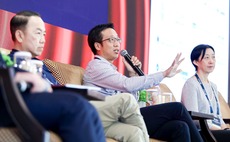
Secondaries: Access all areas?

With sophisticated regional players at one end and smaller novices at the other, navigating Asia’s nascent secondaries market requires patience, teaching skills and reliable information channels
The secondaries market is almost guaranteed to spike in times of uncertainty. When the global financial crisis left LPs grappling with the denominator effect as plummeting public market valuations pushed the alternatives share of their portfolios past permitted levels, sale signs went up. It wasn't the first time - a similar scenario played out after the tech bubble burst, for example.
Navis Capital Partners was deploying its debut fund during this period. The managers ended up buying back about 15% of the corpus from investors that wanted out and, although it turned out to be a lucrative move, there is little expectation of a repeat performance. At $1.1 billion, Navis' most recent fund - its sixth - is more than 15 times larger than the debut vehicle. Putting together the financing for an average size LP stake would be a considerable undertaking.
"We wouldn't do that and we haven't had to do it for a number of years because there hasn't been the turnover one might have expected post-Lehman," says Nick Bloy, co-managing partner at the Asia-focused GP.
"Also, the whole process has become a lot more professional, with large intermediaries and advisors. I'm always getting calls asking if there are any positions available while existing LPs occasionally test values in the market, so you frequently have advisors calling up to ask about the portfolio."
Although there has been progress, Asia remains a mixed bag as far as secondaries are concerned. Campbell Lutyens expects global transaction volume to hit a record high of $30 billion in 2012, but it remains driven by large deals out of Europe and the US. Most of the global intermediaries and secondary specialists are still relatively new to the region, which contributes to a fragmented market.
As for the GPs, their experience with such transactions ranges from comprehensive to non-existent - and this has an impact on how potential buyers present themselves.
"The size and resources of the GP is always an issue," says Chin ChinTeoh, head of Asia at Greenpark Capital. "Larger international brand names have seen these transactions before and with larger funds, they tend to be more cookie-cutter type transactions. Smaller regional funds, particularly those without dedicated IR teams and where the CFO hasn't dealt with secondaries before, tend to be more unfamiliar."
Difficult can manifest itself in several ways. The level of sophistication within individual GPs varies based on the managers' backgrounds, rather than geography. However, industry participants note that countries in which primary due diligence is a challenge - China, for example - are equally problematic on the secondary side. There is a marked difference between the quality of information delivered by a GP that wants to engage compared to one that does not.
Another consideration is that the GP must usually sign off on the transfer of an LP interest. If they aren't comfortable, they might procrastinate or simply deny approval. Education is critical when it comes to persuading a less experienced fund manager of the benefits of change.
"It reminds me of dealing with managers - especially VC managers - in the US in the early 2000s" says Adam Howarth, a senior vice president with Partners Group's private equity secondaries division in Singapore. "It was a new process to them at the time but through a little bit of education they quickly realized the value of recalibrating their investor base. Once we have these conversations with them the GPs get on board with allowing the transfer pretty quickly."
Right of veto
Navis' Bloy recalls refusing to the transfer of an LP interest for three reasons: he didn't know the buyer directly, didn't particularly like their reputation, and didn't want them as an investor. This conclusion was reached in the context of balancing the interests of the GP (reputational risk, potential for distraction from core duties) and those of the existing LPs (the impact of introducing a new party with potentially a different agenda).
On a broader level, fund managers may have obligations to existing investors - in some cases limited partner agreements award right of first refusal to another party should secondary stakes become available - or they just want to play favorites. A GP would much rather do business with an LP that is friendly, and most likely an existing investor in the fund, than a group they don't know at all.
The other issue is fundraising. According to AVCJ Research, private equity firms attracted $22.3 billion in capital commitments during the first half of 2012, the lowest level since 2009. Fewer than 100 funds achieved a close compared to nearly 400 in 2011 as a whole. In the likes of South Korea, Japan and Australia, GPs are reaching out to foreign investors for the first time as domestic LPs withdraw from the asset class.
In the current climate, an institution that wants to forge a long-term relationship with a PE firm and participate in future funds is worth its weight in gold. This appears to offer an edge to the likes of Partners Group, HarbourVest Partners, Pantheon and LGT Capital Partners - that offer secondaries as part of a package that includes primary fund-of-funds commitments - over secondary specialists such as Greenpark, Lexington Partners, Coller Capital and Paul Capital.
"It has to been helpful to have a diverse platform in Asia," says Tim Flower, a principal with HarbourVest in Hong Kong. "On some deals, our team has been more attractive and displaced secondary-only players because we have a primaries platform. In other cases, GPs have refused consent because they didn't want a secondaries specialist and then called up us."
A number of secondaries specialists have for some years included pockets in their main funds for primary investments. It is not unusual for these players to appear on the LP roster for an Asian GP with a commitment of around $5 million to a $2 billion vehicle.
Building a relationship with the private equity firm isn't the only consideration. Serving as an LP means the secondary investor receives the quarterly reports and can attend the annual general meeting. These sources of information are vital when valuing the portfolio if LP interests subsequently come to market, although it's unclear how large a primary stake is required to get a GP's full attention.
Greenpark, however, retains a particular focus in emerging markets: LP interests in mid-size funds. Teoh argues that it is important to convey a consistent approach to investors, noting that different segments of the asset class involve different risk-return profiles. She also has a different take on GPs targeting fund-of-fund LPs with a view to securing primary commitments.
"Attitudes may be different but dealing with a fund that has a lot of primary money and a smaller pocket of secondary money can make it harder to access LPs further up the chain," Teoh says.
"We are very interested in introducing GPs to our LPs because we don't see a conflict. Fund-of-funds can be more defensive with these relationships because they don't want to be dis-intermediated."
Best way in?
In assessing the merits of secondary strategies, deal access is a critical issue. If an LP is selling 50 positions in funds around the world and an Asian GP is just one of them, the first they might hear of it is when the intermediary running the auction gets in touch to say that a group of potential investors wants to conduct a due diligence call. In some cases, GPs are asked to provide pre-approval lists of LPs with whom they are willing to do business.
There are a handful of large buyout funds with broad LP bases - large European and North American institutions that often use the secondary market - that are routinely available to buy and pricing is easy because they are so widely known. The group includes TPG Asia V, KKR Asian Fund, CVC Capital Partners Asia Pacific II and III, Pacific Equity Partners Fund IV, and several vehicles operated by The Carlyle Group.
Reaching deeper into the GP community can mean a departure from the Western-style intermediated auctions. Interests in smaller funds with fewer seasoned LPs might trade relatively rarely and the GP is often informed early on and involved in the search for replacement capital.
"Generally speaking, you find more proprietary deals in Asia because it's more informal and the big secondary houses are only just setting up shop here," says Doug Coulter, head of Asian private equity at LGT Capital Partners . Even in a pool auction in Asia you might only have 5-8 players at most."
He notes that two of the Asian secondary deals LGT has completed so far this year were not intermediated: one came through a GP in which LGT was already invested; the other was introduced by a friendly third party and no potential rival bidders were involved.
Again, the fund-of-funds' primary relationships come to the fore. Some industry participants have invested substantial sums in Asia over more than a decade and have large teams on the ground working with GPs. According to Howarth, it is rare for Partners Group to be dealing with a fund manager that it hasn't already met.
The secondaries specialists, for their part, can also claim to have carved out proprietary channels. China Investment Corporation (CIC) has a separate account within Lexington's most recent $7 billion fund and it is expected to serve as a magnet for larger transactions, effectively expanding the deal pipeline.
Greenpark, meanwhile, last year teamed up with International Finance Corporation (IFC) to create a $500 million emerging markets secondaries fund. IFC has 180 GP relationships and the idea is that Greenpark will have access to a wealth of information on these managers and then get the first call whenever an LP is looking to exit. Teoh says the Greenpark expects to see in excess of $3 billion in emerging markets secondaries this year - most of it from mid-cap, late-stage positions.
"If you look at most emerging markets firms, the fund sizes are sub-$1 billion and so the average LP interest is smaller," she adds. "These tend to be less intermediated so there is less competition."
Choose your strategy
As Western institutional investors increase their exposure to Asian private equity, and as the funds they invest in mature, creating more secondary market supply, processes are likely to become more streamlined. The cookie-cutter approach that exists at the top end among the large pan-regional players is already filtering down into the leading country managers, and this will continue.
However, this doesn't mean the market as a whole will suddenly become less fragmented. There will still be an unruly mid-market populated by future heavyweights and long-term makeweights, and secondary investors will identify a range of opportunities, from pools of LP interests to direct acquisitions of GP portfolios. Industry participants must decide whether they want to cover it all or just certain segments.
"It does come back to the point that there is less intermediation in Asia," says Jason Sambanju, managing director and co-head of Asian operations at Paul Capital, which targets direct secondaries in particular. "You really have to think about deals in a broader sense here."
Pan-regionals: Easy exit
The likes of The Carlyle Group, KKR and TPG Capital are equally adept at handling secondary trades for their Asia funds as for their flagship buyout vehicles run out of the US. Indeed, in many cases there are similarities between the investor bases for these vehicles.
"With the big pan-regional funds, where there are 100-plus LPs, all of them well-known names," says Tim Flower, a principal at HarbourVest Partners in Hong Kong. "The GPs generally want the buyer to be an existing investor and investor that will consider their next fund. They have big investor relations teams that can deal with secondary inquiries."
Carlyle has now taken things a step further. It was reported earlier this year that the GP had attached a liquidity mechanism to Carlyle Partners VI, its latest $10 billion global buyout vehicle that is currently being raised, to facilitate the exit of LPs. Twice a year investors will have the opportunity to sell their positions to a group of secondaries players, including Goldman Sachs, Credit Suisse, Coller Capital, Landmark Partners and Partners Group.
Market sources tell AVCJ that a similar mechanism has been included in Carlyle Asia Partners IV, which is said to be targeting $3.5 billion. Much like the global fund, about half a dozen LPs have agreed to act as liquidity providers, although it is unclear whether the mechanism will operate on the same twice-yearly basis.
The general aim is to assuage investors' concerns about entering an illiquid asset class during a time of market volatility. By keeping the process internal, it also removes the time lag, bureaucracy and fees that are features of an intermediated auction.
"They have done it in other parts of the world, but this is the first time in Asia," says one source familiar with the situation. "It works better with a large diversified LP base. Many LPs see it as a value-added service, even though they don't invest in the fund with the idea of getting out early."
Latest News
Asian GPs slow implementation of ESG policies - survey
Asia-based private equity firms are assigning more dedicated resources to environment, social, and governance (ESG) programmes, but policy changes have slowed in the past 12 months, in part due to concerns raised internally and by LPs, according to a...
Singapore fintech start-up LXA gets $10m seed round
New Enterprise Associates (NEA) has led a USD 10m seed round for Singapore’s LXA, a financial technology start-up launched by a former Asia senior executive at The Blackstone Group.
India's InCred announces $60m round, claims unicorn status
Indian non-bank lender InCred Financial Services said it has received INR 5bn (USD 60m) at a valuation of at least USD 1bn from unnamed investors including “a global private equity fund.”
Insight leads $50m round for Australia's Roller
Insight Partners has led a USD 50m round for Australia’s Roller, a venue management software provider specializing in family fun parks.








